Bodyweight Training:
The Ultimate Guide
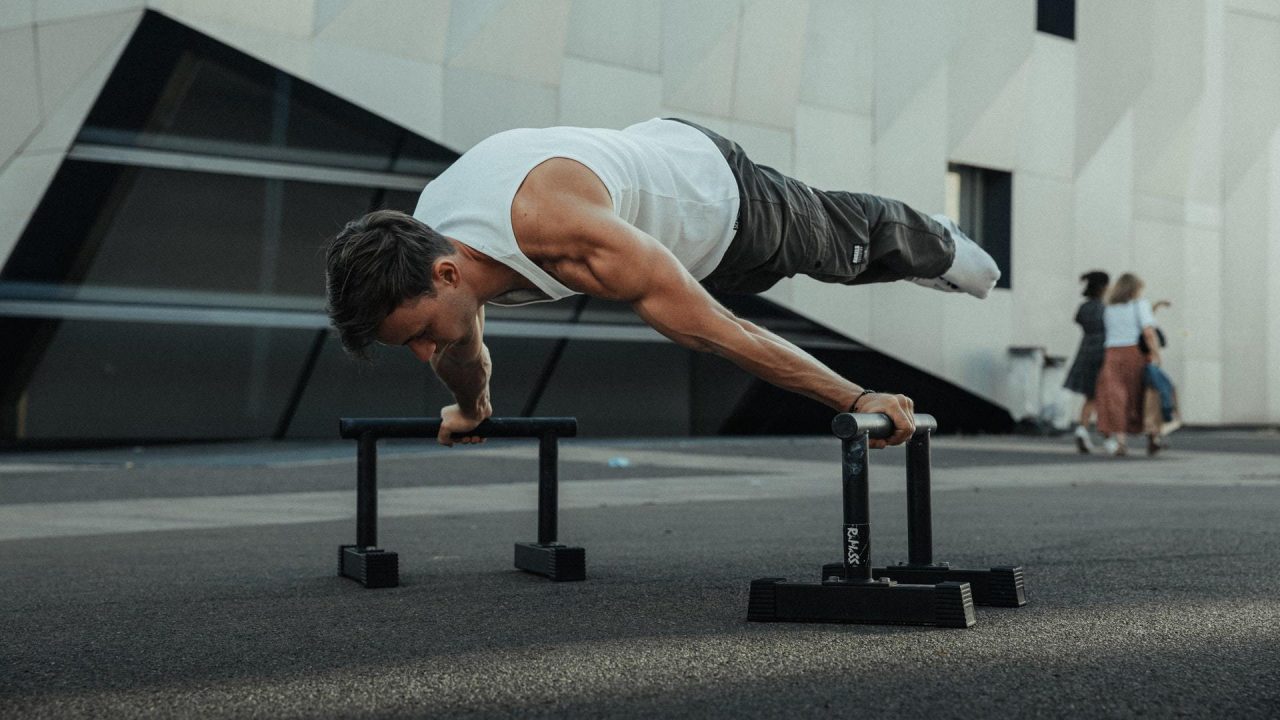
Want to read later? You can download our guide to your computer in PDF format.
Bodyweight training, if you are following us for a while you probably know we are a huge fan of them.
There are so many reasons for that.
In this extensive guide, I am going to explain why. And this guide covers everything a beginner must know.
Our main aim is to increase the awareness of old-school bodyweight exercises in this guide because we intimately believe that they can really do wonders for most of your health goals.
We hope to make everyone who reads this guide a fan of bodyweight training and we hope after you read this guide you will implement them in your workout program. Because we know they work.
If you are ready, let’s begin.
Table of Contents
Part 1 - And Introduction to Bodyweight Training
Part 2 - A Brief History of Bodyweight Training
Part 3 - Why Bodyweight Exercises and Strength Training?

PART 1
An Introduction to Bodyweight Training
Bodyweight training is a form of strength training and basically the art of using the body’s own weight and qualities of inertia as a means of physical development.
You do not require free weights or machines as the individual's own weight provides resistance against gravity.
You can sometimes hear the term 'calisthenics' which means the same thing, bodyweight training. It comes from the ancient Greek kallos meaning “beauty,” and sthénos, which means “strength”.
If you can only think of push-ups and pull-ups when you heard of bodyweight exercises, this is not your fault. For a certain period of the last century, these exercises were deliberately sunk into oblivion. You can guess the reason... yes... they were free!
As some companies had to make money on people who wants to be fit and muscular, these free exercises were useless, there has to be something people would pay for.
Hence, gyms and supplements are born...
They created such an atmosphere that they actually made you believe you had to go to the gym and use supplements to lose weight or gain muscle mass. There was no other way.
Don't get me wrong, I am not an enemy of weight training, gyms or supplements (most of the supplements are garbage and money trap for first-timers, though), but you can totally have a Greek-god-physique just by doing bodyweight exercises for the rest of your life.
If you want proof, just keep reading, I will tell you a little bit of background of calisthenics on the next chapter.
But not today calisthenics, old school calisthenics that created those Greek Gods.

Do you think our fellow muscular god here has ever been to a gym or used supplements?
PART 2
A Brief History of Bodyweight Training
Please don't get scared when you read the word history above, I will keep it very brief, and you will have solid proof of what old-school bodyweight training can really do for you.
Because it really works as it has worked for Greeks, Spartans, or ancient Chinese warriors thousands of years ago.
If you, however, would like to skip the history part and go directly to action, you can jump to Part 3 Why Bodyweight Exercises and Strength Training?
The Long and Honorable History of Bodyweight Training
Bodyweight exercises are as old as humanity because they are fundamental movements like pushing things away, picking up heavy objects from the ground, or pulling yourself to higher ground.
When you read the advantages of bodyweight exercises in the next chapter, you will understand better; all these movements are fundamental and functional. The movements that kept us alive and gave birth to new generations.
Calisthenics is not much used in the strength training community, some professionals even have trouble spelling it correctly.
Today, calisthenics is confused with gymnastics or seen as a form of high-intensity training with high repetition of push-ups or jumping jacks.
But it wasn't always like this.
Ancient people never consider bodyweight training as endurance training. For them, calisthenics was the ideal strength training method.
And old-school bodyweight exercises have been used as the best strength training method for thousands of years.
Have you ever seen the movie 300? Those 300 brave Spartan warriors were really showed unique heroism, and they were some of the best warriors of their time.
Thanks to the notes of the historian Herodotus, today, we know for sure that those soldiers used bodyweight exercises to develop their superior body and strength.
It was 480 BC.
I am sure that the history of bodyweight training goes way beyond that, but this is the first time we have written proof.
But Spartans weren't the only ancient Greeks who had faith in calisthenics. Pausanius documented that all the great athletes of the original Olympic Games were trained in calisthenics.
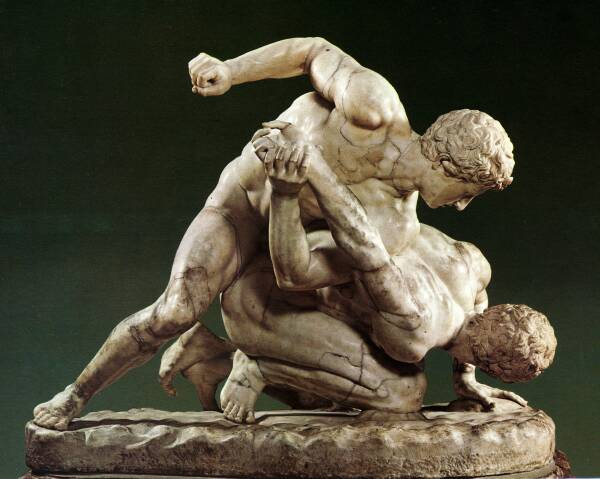
Ancient Olympics Wrestlers – Just look at his body.
The Greeks understood that calisthenics was the best achieving the perfect proportion of the body. And bodyweight was the best weight to use to have that proportion; not too light, not too heavy, just the ideal weight.
Greeks also knew that bodyweight training produced not only great power and athleticism but also grace in movement and beauty of the physical form. This is the origin of the word calisthenics.
We need to consider very carefully that those ancient warriors and athletes were extremely strong, flexible, and good-looking. The statues are the living proof of this.
Greeks passed their knowledge of these exercises to the Romans.
The soldiers of the Roman Military and gladiators used bodyweight training as one of the main parts of their training system. These exercises provided the essential strength, endurance, and flexibility to survive on the battlefield or colosseum.
I don't want to dwell on the subject, so I am going to speed up.
The soldiers sustained the knowledge of the ancients at the military camps of Byzantium and Arabs.
And with the crusades, Europe remembered the forgotten heritage strongly. Medieval soldiers trained for strength with these evolved old-school calisthenics, centuries before the invention of the barbell or dumbbell.
Some of Henry VIII's archers had a draw strength of 200 lbs. Few archers today have that kind of draw strength.
After the Renaissance, these exercises were used by not only military personnel but also used by acrobats and jugglers at circuses. They demonstrated extraordinary skills of strength and flexibility thanks to the bodyweight exercises.
In the nineteenth century, gymnastics, as we know it today, was born from thousands of years of calisthenics experience.
Bodyweight Training at
Twentieth Century
In the late nineteenth century, the era of the strongman was born.
The mighty heroes of this era were Arthur Saxon, Rolandow, and Eugen Sandow, who was also known as the father of modern bodybuilding.
These men have such enormous power, they were even more powerful than the steroid junkies today.
Saxon could press 385 lbs. overhead with one arm; Rolandow could effortlessly tear three decks of cards at once, a feat that should be impossible; and Sandow broke steel chains wrapped around his torso, merely by flexing.
These men achieved those near-impossible feats by bodyweight training. Barbells and dumbbells weren't even invented until the twentieth century.
PART 3
Why Bodyweight Exercises and Strength Training?
Now you know the long and honorable history of bodyweight training.
I didn't write all this to bore you. It was necessary to make you understand these exercises are the best way to have a strong, flexible, functional, and physically appealing body.
You have seen proofs of thousands of years.
But for the sake of this post, I don't want to bore the rest. I think that was enough to understand the importance of old-school calisthenics.
Now the slightly more exciting part: What can bodyweight exercises do for you?
In this part, we will discuss the advantages of bodyweight exercises and strength training.
And why cardio might become a waste of your time, especially if you are overdoing it.
Why Bodyweight Exercises? What Are the Advantages?
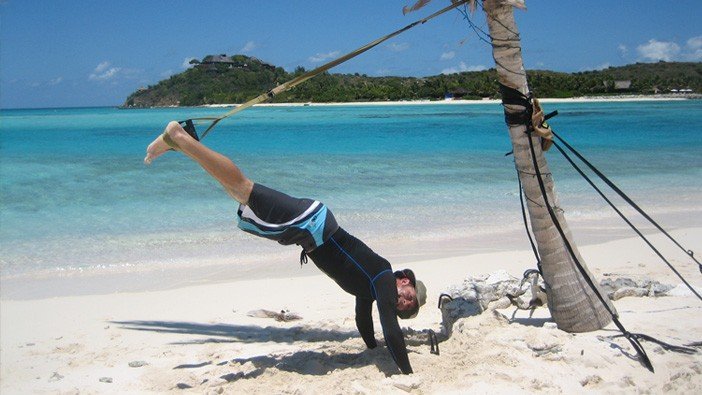
Why bodyweight exercises? Look at the picture; it is fun. He is next to the ocean and breathing the fresh ocean air. Look at how happy he is.
I think I made it quite clear that the popularity of weights, training equipment, and supplements are more of a marketing thing than actually helping to increase the general health of society.
It was inevitable, as capitalism was rising so fast. But now, it is time to open your eyes and educate yourself about it. We have the internet now.
The gyms, weights, and supplements are not evil, but you don't need them to have your dream body or be healthy or strong and muscular.
Most weight training exercises isolate only certain muscles. It means only a small portion of the muscles of your body kick in.
For bodyweight exercises, this is the opposite. For most of the exercises, a large group of muscles works. This enables you to have greater core strength.
Bodyweight exercises keep you safe from chronic joint injuries as they are all-natural movements.
Some heavy weightlifting and other unnatural exercises that have little functional value in our daily lives can cause chronic joint injuries.
Did you notice the word functional?
Next time you go to the gym I want you to take a look at the exercises that people are doing very carefully.
How many of them resemble any functionality that we can benefit from for our daily life?
Not many of them, I guess.
What's the point of being capable of pressing 250 pounds on the bench press while you are incapable of bending touching your feet. Is this a healthy way of shaping your body?
You may have biceps at the size of my freaking head, but what about your tendons and joints?
If you cannot do one proper pull-up with those enormous biceps, triceps, and back, what's the point of having them?
Please think very carefully about all of these.
There's a common misperception out there that bodyweight exercise options are limited. That you cannot adjust the resistance weight as with the weight training exercises.
That is not correct.
Doing the same exercise slightly different, for example, putting your feet on the sofa instead of the ground while doing push-ups, makes the exercise more challenging.
Or you can put your hands on a table while your feet are on the ground. Yes, you guessed it right, an easier variation of the same exercise.
You are seriously in good shape and want to make it really hard; try to do a push-up with only one hand, AND with a long pause at the bottom.
Try doing ten of them. I'd like to see your face afterward.
In short, the only limiting factor with bodyweight exercises is your creativity.
Now, to make things easier for you, I'd like to point out the advantages with a bullet list.
SOME ADVANTAGES OF
BODYWEIGHT TRAINING
- Obviously, the biggest advantage is that you do not need a gym or equipment or machines to exercise. You can train at pretty much anywhere you want, anytime you want.
- There is no cost like monthly gym membership or equipment costs. It is free to train your body with bodyweight exercises.
- Bodyweight exercises impact big muscle groups, you can train many muscle groups with a single exercise. This is especially a bigger advantage if you are a beginner.
- Bodyweight exercises, compared to using heavy weights or machines, have a lot less injury risk. Because there is no risk of dropping a ton of weight to your chest or legs. I say this of course thinking that you are doing bodyweight exercises in correct form.
- Bodyweight exercises can enhance a range of bio motor abilities including strength, power, endurance, speed, flexibility, coordination and balance. So, you are not just building muscle while you are doing bodyweight exercises, you also improve your strength, stamina, endurance and fat burning process.
Of course, you might be wondering also about the disadvantages.
DISADVANTAGES OF
BODYWEIGHT TRAINING
- Bodyweight exercises don’t have much disadvantage but they might be a little daunting for beginners at first. Because you use your own body weight as resistance, you may have difficulties dealing with your own weight at first. But there are simple ways to eliminate this problem as I will explain in detail later in the guide.
- If you think the opposite way, the amount of weight you lift is never more than your own body weight. So, they can be seen as very easy for experienced athletes. But there are also simple ways to add difficulty and intensity to your bodyweight workout plan. I will also explain this later.
Why Strength Training? And Is Cardio a Waste of Time?
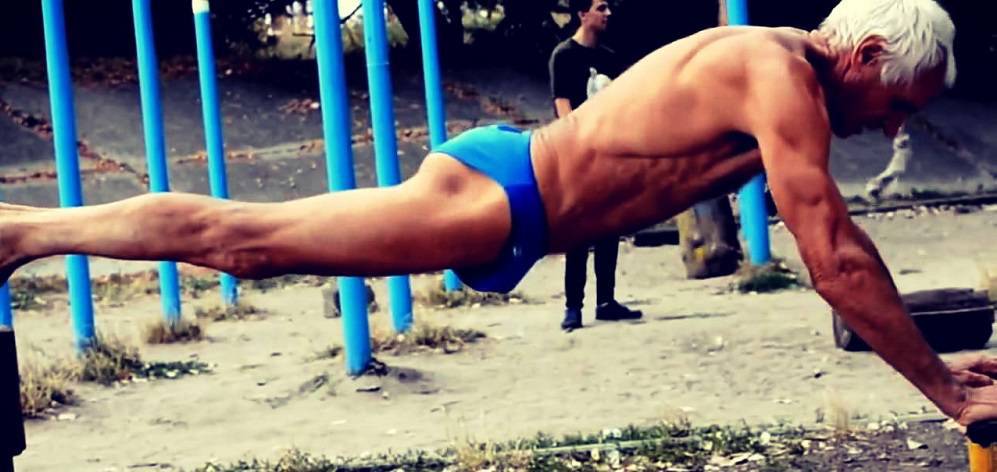
What is the reason he is so fit and healthy at this age? Yep, you guessed it right, strength training!
Whatever your goal is (losing fat, making muscle, being generally healthier, increasing your endurance and strength), strength training should be the core of your training system.
I don't like to use terms like 'cardio is useless' or 'you shouldn't do cardio’. Cardio is good for your health.
But even if your main goal is to lose fat, aerobic exercises should not be your primary and only concentration.
I will explain why in detail but to make a long story short: probably all of you need more muscle!
Yep, it is that simple.
Our main goal is always to lose the fat and add muscle mass because fat is dead tissue and does not burn calories while we take a nap.
Muscles, on the other hand, are very much alive and consume a lot of calories, even if we are sitting on our couch, watching TV.
Muscles enable us to do functional things like grabbing a remote controller on the seat or throwing paper planes at our friend's head just to annoy him. But most importantly, they burn lots of calories.
If you can add ten pounds of muscle to your body, you can increase your resting metabolic rate by 100 calories. Yes, it takes about ten calories a day just to keep one pound of muscle alive, for both men and women, even if you are completely inactive.
But if you do a crazy amount of cardio every day just to burn fat and lose weight, you will probably burn half of those precious muscles along with the fat. That means your body will burn 50 calories less every day. Not so efficient, right?
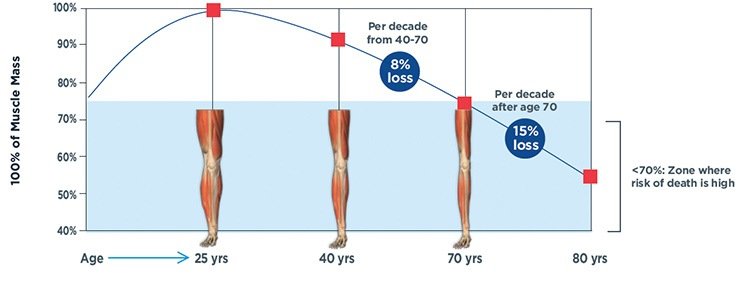
Sarcopenia - Also known as muscle loss with age. But this is not a destiny for everyone. You can change this if you learn how to make bodyweight exercises a part of your daily life.
Everyone starts to lose their muscle tissue after a certain age. As you lose your muscle mass, the metabolic rate of your body also decreases. And gaining weight becomes easier for you, especially if your eating habits won’t change throughout the years.
Then as the years' pass, you slowly and consistently gain weight, and at some point, you look at the mirror and say: 'What the hell happened to me?'
You didn't do any strength training. You don’t have enough muscle mass. That's what happened.
But now that you know what to do, you can prevent all of those.
Let's get you started bodyweight strength training.
PART 4
How Can You Start Bodyweight Training?
You know all the advantages of bodyweight training now and what these exercises can do for you.
Without going to the gym, you can train pretty much anywhere and reach your goals, whether it’s weight loss, gaining muscle, becoming fit, or getting strong.
Bodyweight training can do all of these for you. It’s a fact. I’d like you to believe in that because believing is what makes you take action and go through all that hard stuff.
Now, the most important part. Action.
How are you going to start, even if you are a complete beginner?
The good thing is, we have a leveling system with every movement that you can exercise in the most suitable form for you.
Every exercise has a complete beginner mode that even a senior with zero strength training can easily follow.
And as you progress, you level up in every particular exercise. So when you are comfortable at that specific level, you will increase the difficulty and continue training until you become comfortable at that level.
And hence, you create constant growth for your body.
For example, regular push-ups might be challenging for a beginner, but that doesn’t mean you won’t be able to do push-ups until you reach a certain upper body strength.
There are ways we can alter the difficulty of the exercise.
You can do push-ups on your knees, and bam! It’s much easier now.
Still having difficulties?
Try to put your hands on higher ground like a chair or sofa while still on your knees. It becomes even easier.
Still hard for you to keep up?
No worries.
You can do wall push-ups. Just face a wall and put your hands on the wall, and do wall push-ups!
Everyone, and I mean literally almost everyone, can do that.
And you just start from there and train until wall push-ups become easy for you.
Believe me, if you keep exercising consistently, you will get used to it fast. In fact, you may surprise how quickly it becomes so easy for you.
Then you start doing table push-ups on your knees.
Then you start doing knee push-ups on the floor.
And then, when you do your first regular push-up, you are going to feel incredible.
So strong. So proud of yourself.
And you’ll want more.
And by that time, you are hooked.
All you have to do is following your training program until you become comfortable with the current difficulty and then level up.
It’s that simple.
And all you need is 2-3 hours a week.
But you have to be consistent and do every exercise in the correct form.
That’s it.
Now, let’s begin your bodyweight workout plan.
Beginner Bodyweight Workout Plan
This workout plan is great for beginning bodyweight strength training. It will work every major muscle group in your body.
And one important thing before starting your exercise is warming up, which is so overlooked by so many people.
ALWAYS warm up before any exercise; otherwise, it is almost guaranteed that you injure yourself at some point.
Because you are not going to use heavy weights and not train heavy at first, a simple 2-3-minute dynamic warm-up is enough.
Just shake your hands and legs, jump where you stand, clap your hand above your head while jumping and moving your feet.
You have to make this a habit and warm up EVERY TIME before you start exercising.
Now that you are warmed up, you are ready for the training.
You can [download our free beginner bodyweight training e-book]. You’ll find the workout program and all exercises below in the e-book: the videos, the explanations, everything.
It’ll be much easier for you to follow up on everything, and you can print the workout plan and mark your reps.
Let’s learn the exercises.
1. Push-ups
The first exercise is, of course, push-ups.
There is a reason why push-ups are one of the three main strength training exercises, and everyone is doing them (sometimes in the form of bench press).
Push-ups train almost every upper body muscle group.
Because of this, if you have to choose one exercise to train your upper body for the rest of your life, that’ll definitely be push-ups.
Let’s learn how to do it properly.
[Image or video of push-ups]
2. Walking Lunges
The lunge is an excellent exercise for your lower body. It works several lower body muscle groups at the same time.
You can place your hands on your hips, as shown in the picture, or you can use dumbbells if you have a pair to make the exercise harder.
Don’t rush while you are doing the exercise. Do it slowly and focus on your balance and form. You may have balancing issues in the first few weeks, but your body will adapt to it after a while.
And don’t worry about the variations right now. Focus on technique.
[Image or video of walking lunges]
3. Assisted Pull-ups
Pull-up is the second exercise to shape your upper body. Combined with push-ups, they are enough to have a superb upper body. Together they work all upper body muscles.
The thing is, there is no substitute for pull-ups. So, I suggest you buy one pull-up bar. They are very cheap (20 bucks at max) and durable. And you need a regular chair or band if you are a beginner.
You will use the chair or bands to support you, and the exercise will become much easier. Just be sure the chair is not moving.
If you can do three reps without a chair or bands in the correct form, that’s wonderful. You have learned the pull-ups.
[Image or video of assisted pull-ups]
4. Bodyweight Squats
The squat is one of the three main strength training exercises that ever existed with push-ups and deadlifts. They are also known as The Big Three.
The squat is such an effective exercise that you can only do it to develop your lower body muscles for the rest of your life. It works nearly all the lower body muscle groups.
But, and this is a big BUT, you have to be very careful while doing it because the wrong form might cause knee injuries (This is a low probability for you, though, as you are not using heavy weights).
Start with half squats, as shown in the picture. You may progress to full squats as you develop your lower body.
[Image or video of bodyweight squats]
5. Plank
Plank is a great isometric exercise to strengthen your core.
Isometric exercise means you don’t move any body parts, but you do the exercise in a static position.
The plank strengthens the abdominals, back, and shoulders.
The most common plank is the front plank which I recommend you to start with. You can see the correct form in the picture.
Start with 10-20 seconds and test your body. You can increase the time as you progress.
[Image or video of plank exercise]
How to Best Utilize These Exercises for Yourself?
Finally, you learned the exercises.
And this brings us to the final part: Your workout.
How do you implement these exercises in your workout? What are the sets and reps for each exercise? How much should you wait between sets?
And the answer to all of these is circuit training.
What is circuit training?
Well, it brings the benefit of both strength training and cardio exercises.
You do all five exercises without any rest between them. As long as you finish your push-up exercise, you start lunges, and so on. When you finish all five exercises, that’s your first set, and you rest 2-3 minutes. And start all over again for the second set.
You can do 2-3 sets in total according to your energy.
It’s totally normal to feel exhausted, especially in the first couple of weeks. If you feel entirely exhausted, finish the training with 2 sets.
As your body gets used to the training, you can do 3 sets.
Don’t ever push your body too far or to the limits in the beginning. Instead, let your body get accustomed to exercising.
But at the same time, you have to feel tired after the sets. Otherwise, it means the exercises are too easy for you, and you don’t progress as desired.
So, start with the easy variations of each exercise, and work your way up to more challenging variations.
The same applies to the reps.
Try to get at least 8-10 reps. If you can barely do 3-4 reps, it means that variation is too hard for you. Try lower difficulty variation. (Pull-ups are an exception here).
The workout plan starts with upper body exercise, followed by a lower-body exercise. And then another upper body exercise, followed by another lower body exercise, and finally finishes with a core exercise.
Because of this arrangement, even though you are not resting between exercises, each muscle group has a relief time.
And because you are not resting between exercises, your heart rate is high throughout the workout, meaning it’s great for losing fat.
And you are also strength training, meaning you are building muscle.
That’s the beauty of circuit training.
And that’s why this is the best workout plan for beginners.
Below is one example workout plan that you can use as a complete beginner, and as you progress, you can increase reps and sets and also increase difficulty.
BEGINNER WORKOUT PLAN:
Wall or Knee Pushups – 8-10 reps
Half Lunges – 8 reps for each leg
Assisted Pull-ups – 2-3 reps
Half Bodyweight Squats – 8-10 reps
Plank – 10-15 seconds
As you get used to the beginner workout plan and your body is comfortable doing all of the above exercises with at least 15-20 reps, 3 sets, you can start using the advanced workout plan.
It may take 1-3 months, according to your body and your training background.
ADVANCED WORKOUT PLAN:
Push-ups – 10-15 reps
Lunges – 12-15 reps for each leg
Pull-ups – 2-3 reps
Full Bodyweight Squats – 15 reps
Plank – 25-30 seconds
Start with the beginner workout plan and shape it according to your body with all you have learned from this post.
With a proper diet plan, if you follow this type of training, there is no chance you will fail.
Final Words
This workout plan is all you need to start reaching your goals, whether weight loss or gaining muscle and strength.
It has worked for thousands before, and it’ll definitely work for you if you follow this guide.
The purpose of this post is to educate you about bodyweight exercise and remind you that you don’t need gyms and weights to lose weight or build muscle.
You can use these exercises to prepare your body, your tendons, and joints for future heavy workouts at the gym if that’s what you want. Or you can do bodyweight exercises for the rest of your life. The choice is yours.
But if you want a healthy and good-looking body for the rest of your life, you have to implement exercises in your life. You have to make this a lifestyle.
You have to like what you are doing. Otherwise, it is impossible to force yourself something you hate for such long periods of time.
In other words, you have to find your favorite exercises and do them. That’s the only way.
And I sincerely believe that an outdoor bodyweight exercise is so fun, such a wonderful thing you can do for your body, and will probably be liked by so many of you, compared to trying to force yourself to go to the gym, even though you hate it.
Those were in my mind before creating this guide. So that’s the reason this post was made.
I hope it will be helpful for you.
If you like this content and it really helped you, please share and subscribe to our mailing list for more in-depth content like this.
Thanks, and good luck.


GET ACCESS to our free Bodyweight Exercises and Healthy Recipe E-books and free 7-day mini course
Plus you will get blog posts and quick fitness, nutrition and sleeping tips delivered to your e-mail every week.
